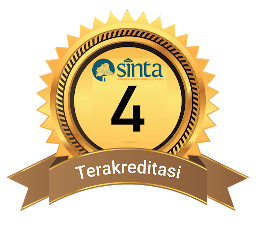Development of Structured Assignment Sheet in Reaction Rates Material To Train Science Process Skills
DOI:
10.29303/cep.v4i2.2312Published:
2021-08-14Issue:
Vol. 4 No. 2 (2021): Edisi Khusus Penelitian Pengembangan dalam rangka ulang tahun CEP yang ke 4Keywords:
Structured Assignment Sheet (SAS), Science Process Skills (SPS), Reaction RateArticles
Downloads
Additional Files
How to Cite
Abstract
This study has an objective to specify the feasibility of a Structured Assignment Sheet to train studentsââ¬â¢ Science Process Skills (SAS-SPS) on reaction rates material. The development research applies Research and Development (R&D) method. This research is limited to the development phase, namely in limited trials. The limited trial was conducted on 15 students of XI grade from SMAN 1 Arosbaya, SMAN 1 Kamal, and SMAN 2 Bangkalan who had received reaction rates material. This research was held in December 2020. The research instruments used contain a study sheet, a validation sheet, a student response questionnaire, and science process skills test sheet. The feasibility of the SAS-SPS is viewed from three aspects, namely validity, practicality, and effectiveness. The validatorââ¬â¢s assessment based on the content and construct validity represent the percentage of 93,3% and 91,4% with very valid criteria. Student response shows that the SAS-SPS is very practical with a percentage of 100%. The effectiveness of obtaining an N-gain score of 0,76 with a high category. This shows that the SAS-SPS developed is feasible and suitable for use in the learning process.
References
Aydin, A. (2013). Representation of Science Process Skills in The Chemistry Curricula for Grades 10, 11 and 12 / Turkey. International Journal of Education and Practice, 1(5), 51ââ¬â63.
Fitriana, Kurniawati, Y., & Utami, L. (2019). Analisis Keterampilan Proses Sains Peserta Didik Pada Materi Laju Reaksi Melalui Model Pembelajaran Bounded Inquiry Laboratory. JTK (Jurnal Tadris Kimiya), 4(2), 226ââ¬â236.
Hadi, S., & Novaliyosi. (2019). TIMSS Indonesia (Trends in International Mathematics and Science Study). Prosiding Seminar Nasional & Call For Papers Program Studi Magister Pendidikan Matematika Universitas Siliwangi, 562ââ¬â569.
Hake, R. R. (1998). Interactive-Engagement Versus Traditional Methods: A six-Thousand-Student Survey of Mechanics Test Data for Introductory Physics Courses. American Journal of Physics, 66(1), 64ââ¬â74.
Kheng, Y. (2008). Longman Science Process Skill. Selangor Darul Ehsan: Pearson Malaysia.
Lutfi, A., & Hidayah, R. (2018). Manajemen Sekolah. Surabaya: UNESA University Press.
Ningsih, N. L. ., Karyasa, I. W., & Suardana, I. N. (2015). Pengembangan Perangkat Pembelajaran Kimia Dengan Setting Sains Teknologi Masyarakat (Stm) Untuk Meningkatkan Keterampilan Proses Sains Dan Pemahaman Konsep Kimia Siswa. Jurnal Pendidikan Dan Pembelajaran IPA Indonesia, 5(1), 1ââ¬â11.
Nurliani, Sartika, R. P., & Hadi, L. (2018). Deskripsi Keterampilan Proses Sains Siswa Kelas XI IPA SMA Negeri 2 Sungai Raya pada Materi Asam Basa. Jurnal Pendidikan Dan Pembelajaran Khatulistiwa, 7(7), 1ââ¬â14.
OECD. (2018). What 15-Year-Old Students in Indonesia Know and Can Do. Programme for International Student Assessment (PISA) Result from PISA 2018, 1ââ¬â10.
Permendikbud. (2013). Peraturan Menteri Pendidikan dan Kebudayaan Republik Indonesia Nomor 54 Tahun 2013 Tentang Standar Kompetensi Lulusan Pendidikan Dasar dan Menengah. Jakarta: Kementrian Pendidikan dan Kebudayaan.
Permendikbud. (2016a). Peraturan Menteri Pendidikan dan Kebudayaan Republik Indonesia Nomor 21 Tahun 2016 tentang Standar Isi Pendidikan Dasar dan Menengah. Jakarta: Kementrian Pendidikan dan Kebudayaan.
Permendikbud. (2016b). Peraturan Menteri Pendidikan dan Kebudayaan Republik Indonesia Nomor 22 Tahun 2016 tentang Standar Isi Pendidikan Dasar dan Menengah. Jakarta: Kementrian Pendidikan dan Kebudayaan.
Permendikbud. (2018a). Peraturan Menteri Pendidikan dan Kebudayaan Republik Indonesia Nomor 36 Tahun 2018 tentang Kurikulum 2013 Sekolah Menengah Atas/Madrasah Aliyah. Jakarta: Kementrian Pendidikan dan Kebudayaan.
Permendikbud. (2018b). Peraturan Menteri Pendidikan dan Kebudayaan Republik Indonesia Nomor 37 Tahun 2016 tentang Kompetensi Inti dan Kompetensi Dasar Kimia SMA/MA. Jakarta: Kementrian Pendidikan dan Kebudayaan.
Riduwan. (2015). Skala Pengukuran Variabel-Variabel Penelitian. Bandung: Alfabeta.
Sastradewi, P. F., Sadia, I. W., & Karyasa, I. W. (2015). Pengembangan Perangkat Pembelajaran Kimia Yang Menerapkan Model Problem Based Learning (Pbl) Untuk Meningkatkan Pemahaman Konsep Siswa. Jurnal Pendidikan Dan Pembelajaran IPA Indonesia, 5(1), 1ââ¬â12.
Sugiyono. (2015). Metode Penelitian Kuantitatif, Kualitatif, dan R&D. Bandung: Alfabeta.
Author Biographies
Eka Andini Santoso, State University of Surabaya
Suyono Suyono, State University of Surabaya
License
Authors who publish with Chemistry Education Practice agree to the following terms:
- Authors retain copyright and grant the journal right of first publication with the work simultaneously licensed under a Creative Commons Attribution License 4.0 International License (CC-BY-SA License). This license allows authors to use all articles, data sets, graphics, and appendices in data mining applications, search engines, web sites, blogs, and other platforms by providing an appropriate reference. The journal allows the author(s) to hold the copyright without restrictions and will retain publishing rights without restrictions.
- Authors are able to enter into separate, additional contractual arrangements for the non-exclusive distribution of the journal's published version of the work (e.g., post it to an institutional repository or publish it in a book), with an acknowledgement of its initial publication in Chemistry Education Practice.
- Authors are permitted and encouraged to post their work online (e.g., in institutional repositories or on their website) prior to and during the submission process, as it can lead to productive exchanges, as well as earlier and greater citation of published work (See The Effect of Open Access).






